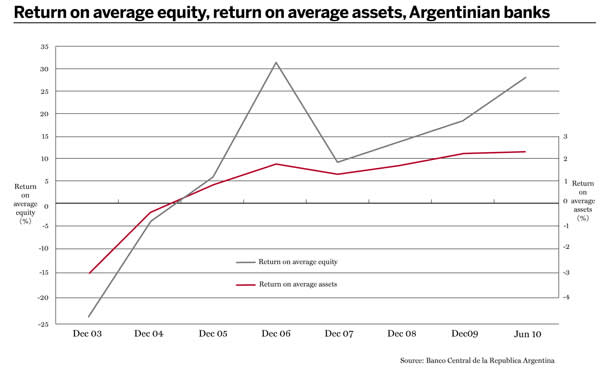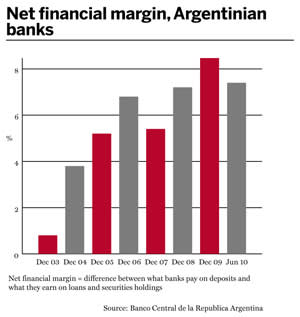Argentine banks made record profits last year on the back of a booming economy but face great uncertainty as runaway inflation is endangering economic growth, according to local experts.
The country’s gross domestic product (GDP) expanded by about 9% last year and banks made a total net profit of more than 11bn pesos ($2.73bn), according to the Argentine Banking Association (ABA) – the best result in more than a decade. The ABA data refers to the 12 months to November 2010. An appreciation in government debt paper – which accounts for a high proportion of the portfolio of many banks – was key and explained almost 40% of the profits.
Expansion in credit
Profitability was also reinforced by a big expansion in credit: total loans written by the private sector banks rose by 29.4% between September 2009 and September 2010. Santander Río, Galicia, HSBC, Citi, Standard Bank and Banco Patagonia expanded credit at an even faster rate. For example, Galicia, the country’s largest privately owned bank, grew its credit level by 51.1% and became the third largest bank in Argentina by size of loan book, after Banco de la Nación and Banco Santander Río.
Overall, private sector banks had a return on assets (ROA) of 3% and a return on equity (ROE) of 23% during the first 10 months of last year, whereas public sector banks had an ROA of 2.9% and an ROE of 23.2%. Santander Río was the most profitable with an ROE of 64.3%, followed by BBVA Banco Francés with 43% and Banco Ciudad with 36%.
“The economy has been expanding at a very brisk pace, helping to boost banks’ profits,” says Alberto Ramos, Argentina analyst at Goldman Sachs. “But it is not necessarily healthy or sustainable and there is the possibility of a crash landing next year. There has been excessive fiscal and monetary expansion, and, unofficially, inflation now stands at between 25% and 27%.”
He adds: “The economy grew rapidly last year from a low base in 2009 because of an excellent cereal harvest, a big rise in commodity prices and a large expansion in industrial exports to Brazil. It is not clear if those trends will continue. This year there are presidential elections in November and we believe the incumbent government could overdo it on the monetary and fiscal sides.”
Mr Ramos says the government has been using the exchange rate as an anchor to control accelerating inflation but that this has eroded the competitiveness of many industrial sectors and will really have its strongest impact next year.
Sound but small
“Argentina has a very sound banking system that is prudentially managed,” says David Mermelstein, a banking analyst at Econviews, a Buenos Aires-based economics consultancy. “It is also one of the most profitable systems in Latin America. The problem is that it is small: total [bank] credit against GDP is only 12% in Argentina, compared with 45% in Brazil and 60% in Chile. There is no long-term credit in the country. The mortgage market is miniscule.”
Mr Mermelstein says inflation is the biggest threat to the economy and banks’ profits. “The high rates of inflation create a great deal of uncertainty about the future, which stops banks from lending over the longer term. Banks did very well last year, mainly because of the appreciation in government paper. There is no guarantee that will recur in the future and banks’ profitability could be undermined by a wage-price spiral that pushes up their salary bill.”
Cards and loans
Last year, the banks – private sector banks, in particular – aggressively competed with one another in two main areas: consumer credit, especially through personal loans and credit cards, and loans for small to medium-sized enterprises (SMEs).
Banco Galicia says in a recent report: “We have expanded our principal credit lines: in credit cards, which have seen an increase in their use for consumption purposes of more than 45%, stimulated by the issuing of new cards and by promotions and payments for goods in instalments; in personal loans, where higher salaries have resulted in clients seeking finance for home improvements and the purchase of new cars; and in the corporate market, especially for micro-enterprises and SMEs, with a rise in financing needs for expansion in their production capacity.”
Last year, the banks issued 4.5 million new credit cards. The most aggressive were Banco de la Nación (which increased its stock to 1.2 million cards), Santander Río (with 600,000 new cards, reaching a total of 2.8 million), Galicia (with 1.1 million new cards for a new total of 2.4 million) and Standard (a rise from a total of 796,900 to 1.5 million).
“In real terms, credit has not been expanding in the country,” says Andrea Manavella, Argentina banks analyst at Moody’s. “Negative real interest rates have underpinned banks’ profitability. However, the banks’ cost base is growing more rapidly than the level of revenue from loans. Owing to the stability of the exchange rate with the dollar, bank deposits have continued to grow despite negative real interest rates.”
Mario Vicens, president of the Argentine Banking Association, the main trade body for foreign-owned banks in the country, says: “The big pick-up in credit was in the final quarter last year. Between the start of the international financial crisis and the final quarter last year, credit growth was flat. The economic boom has led to many SMEs demanding additional credit to expand their businesses. Furthermore, inflation uncertainty is leading many people to make purchases, especially of cars and durable goods, sooner rather than later.
“There has been aggressive competition between the banks, especially in the area of products for the middle classes: they are employed in the formal sector and have the highest purchasing power. It can be hard for people to switch bank accounts in Argentina. Not as difficult as trying to take your mobile phone number with you if you change provider, but it is still tricky. However, a number of banks have attempted to woo new customers and adopted systems to make it much easier for clients to open new accounts.”
Geographical coverage
One of the biggest issues for the Argentine banking system is geographical coverage: 94.2% of the urban population have access to a bank branch and 97.2% of people who live in larger towns, with more than 2000 inhabitants, have access to a branch. However, among a total population of 36 million (according to the 2001 census), some 925,000 people do not have access to a local branch.
ABA says the country requires 5600 additional bank branches (on the basis of 5000 clients per branch). Some 45% of them would have to be opened in locations where currently there are no branches.
“Geographic coverage is the biggest problem for the banks,” says Mr Vicens. “Argentina is a vast country and, although there are plenty of branches in Buenos Aires and other major urban centres, many rural areas do not have access to banking. It is expensive to open a new branch in the country and a bank requires considerable economies of scale. In Argentina, banks do not have a sufficiently diversified portfolio and that creates risks: they concentrate on certain credit lines, mostly consumer, and their banking is restricted to the urban centres.”
Carlos Heller, president of Banco Credicoop, the largest co-operatively owned bank in Argentina, says: “The biggest challenge is to increase the system’s bancarisation, improving the level of monetisation and personal loans as a proportion of GDP. This is a task that must be shared with the national monetary authorities. We must try to create a financial system that is more supportive of credit for production purposes and has less emphasis on personal loans.
“Widening the geographic coverage and including more people within the system are important issues; they are objectives that require a special regulation from the central bank. There has been some progress on this front in recent months, with the creation of a free, universal account and the setting up of new rules for the opening of new branches. More needs to be done.”
Political questions
Argentina faces presidential elections in November this year. It is not yet clear whether Cristina Kirchner, whose husband and political soulmate Néstor Kirchner died from a sudden heart attack in October, will again represent the ruling Peronist Party, despite a strong rise in her popularity since his death. The election is likely to go to a second round and a candidate from the Peronist Party is the favourite to win because of its dominance of the political system and the strong economic performance.
The government is not likely to try to rein in inflation by means of tighter fiscal and monetary control before the election, and there is a risk that inflation will accelerate even further, undermining the economy and the banking system.


Re-entering the markets
One of the biggest challenges for the government since the 2001 economic meltdown has been to try to re-enter the international financial markets. The government is in talks with the Paris Club about paying back a total of between $8bn and $9bn owed to it in principal and interest.
The club had insisted that Argentina follow an International Monetary Fund programme to oversee tighter monetary control, but local experts say the government has wrung concessions and this no longer looks necessary. The Paris Club is pushing Argentina to pay back a lump sum of about $4bn, but the government is still bargaining with it to reduce that to a much smaller sum.
Argentinian banks had a bumper year in 2010 and are likely to record a strong performance in 2011. However, their portfolio is not diversified in terms of credit lines or geographical coverage. Inflation remains the country’s greatest issue, hindering long-term credit and presenting the spectre of an economic bust next year. The government must act soon to rein it in, so that the economic outlook remains robust and so that the solid performance by the banks is sustained.












